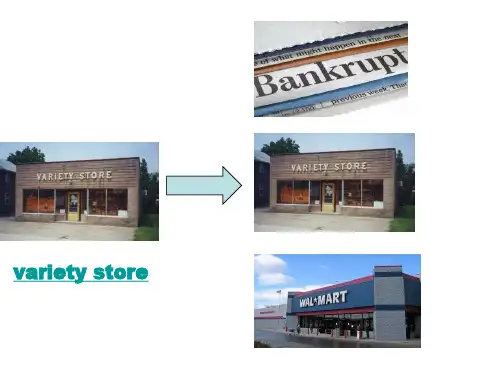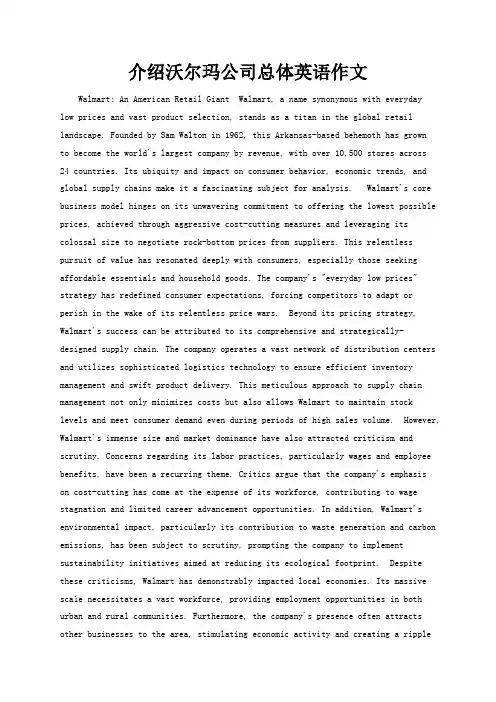沃尔玛英文介绍
- 格式:ppt
- 大小:3.20 MB
- 文档页数:10




沃尔玛:全球零售巨头的崛起与影响Walmart, a multinational retail corporation, has emerged as a global leader in the retail industry, revolutionizing the way people shop worldwide. Founded by Sam Walton in 1962, Walmart has grown exponentially to become the largest private employer in the world, with over 2.2 million employees across the globe. The company's success can be attributed to its innovative business model, customer-centric approach, and relentless pursuit of cost-efficiency.Walmart's business model is unique in its ability to offer a wide range of products at low prices. By leveraging its scale and purchasing power, Walmart is able to negotiate better deals with suppliers, passing the savings onto its customers. This strategy has enabled Walmart to establish itself as a one-stop shopping destination for consumers, offering everything from groceries toelectronics at affordable prices.The company's customer-centric approach is evident in its commitment to providing exceptional service and convenient shopping experiences. Walmart stores aredesigned to be user-friendly, with clear signage, ample parking, and helpful staff. Additionally, the company has embraced technology to enhance the shopping experience, offering online shopping, mobile apps, and in-store pickup options.Walmart's commitment to cost-efficiency is reflected in its meticulous supply chain management and lean operations. The company has implemented advanced logistics systems to ensure timely delivery of goods to its stores, minimizing inventory costs and wasted resources. Walmart also focuses on sustainable practices, reducing its environmental impact and operating more efficiently.Beyond its financial success, Walmart has had a significant impact on the global economy and society. The company's vast supply chain has created millions of jobsfor suppliers, manufacturers, and distributors, driving economic growth and development in many regions. Walmarthas also been a champion of corporate social responsibility, investing in community development, education, and environmental conservation efforts.However, Walmart's rise to global prominence has not been without controversy. The company has faced criticismfor its impact on small businesses, wage practices, andlabor standards in some of its supply chain locations. These issues have prompted Walmart to reevaluate its business practices and implement changes to addressconcerns and improve its social and environmental footprint. Despite these challenges, Walmart remains a powerful force in the retail industry, shaping the way people shop and businesses operate globally. The company's success is a testament to its innovative business model, customer-centric approach, and commitment to cost-efficiency. As Walmart continues to evolve and adapt to changing market conditions, it remains to be seen how it will continue to shape the future of retail.**沃尔玛:全球零售巨头的崛起与影响**沃尔玛作为一家跨国零售企业,已经在全球零售行业中崭露头角,彻底改变了人们的购物方式。







介绍沃尔玛公司总体英语作文Walmart: An American Retail Giant Walmart, a name synonymous with everydaylow prices and vast product selection, stands as a titan in the global retail landscape. Founded by Sam Walton in 1962, this Arkansas-based behemoth has grownto become the world's largest company by revenue, with over 10,500 stores across24 countries. Its ubiquity and impact on consumer behavior, economic trends, and global supply chains make it a fascinating subject for analysis. Walmart's core business model hinges on its unwavering commitment to offering the lowest possible prices, achieved through aggressive cost-cutting measures and leveraging its colossal size to negotiate rock-bottom prices from suppliers. This relentless pursuit of value has resonated deeply with consumers, especially those seeking affordable essentials and household goods. The company's "everyday low prices" strategy has redefined consumer expectations, forcing competitors to adapt or perish in the wake of its relentless price wars. Beyond its pricing strategy, Walmart's success can be attributed to its comprehensive and strategically-designed supply chain. The company operates a vast network of distribution centers and utilizes sophisticated logistics technology to ensure efficient inventory management and swift product delivery. This meticulous approach to supply chain management not only minimizes costs but also allows Walmart to maintain stocklevels and meet consumer demand even during periods of high sales volume. However, Walmart's immense size and market dominance have also attracted criticism and scrutiny. Concerns regarding its labor practices, particularly wages and employee benefits, have been a recurring theme. Critics argue that the company's emphasison cost-cutting has come at the expense of its workforce, contributing to wage stagnation and limited career advancement opportunities. In addition, Walmart's environmental impact, particularly its contribution to waste generation and carbon emissions, has been subject to scrutiny, prompting the company to implement sustainability initiatives aimed at reducing its ecological footprint. Despite these criticisms, Walmart has demonstrably impacted local economies. Its massive scale necessitates a vast workforce, providing employment opportunities in both urban and rural communities. Furthermore, the company's presence often attracts other businesses to the area, stimulating economic activity and creating a rippleeffect of job creation. This economic impact, however, is not without its drawbacks. Critics argue that Walmart's entry into local markets often leads to the displacement of smaller, independent businesses that cannot compete with the retail giant's pricing power. Looking ahead, Walmart faces a dynamic and rapidly evolving retail landscape marked by the rise of e-commerce, shifting consumer preferences, and heightened competition from online giants like Amazon. In response, the company has strategically invested in its online presence, expanding its e-commerce platform and enhancing its delivery capabilities to cater to the growing demand for online shopping. Furthermore, Walmart has shown a willingness to experiment with new technologies, such as artificial intelligence and automation, to streamline its operations, enhance customer experience, and maintain its competitive edge. In conclusion, Walmart's story is one of ambition, innovation, and relentless pursuit of efficiency. Its evolution from a single discount store in rural Arkansas to a global retail behemoth reflects the company's adaptability and its keen understanding of consumer desires. While its practices have attracted criticism, Walmart remains a dominant force in the retail sector, continually adapting to changing market dynamics and striving to maintain its position as a leader in the global marketplace. Its future success hinges on its ability to balance its commitment to low prices with its responsibility towards its workforce, the environment, and the communities it serves.。